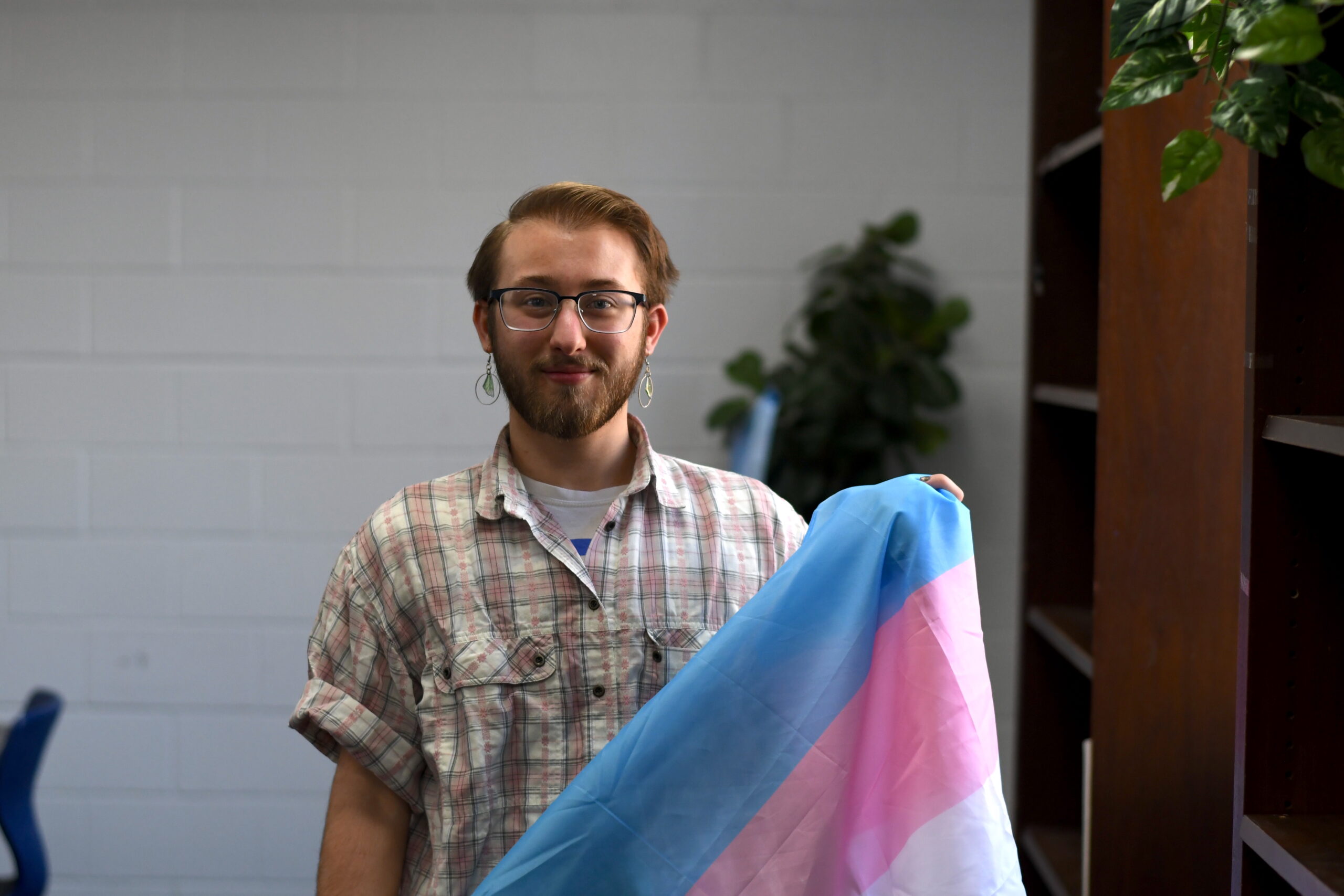
Transition Trials: new restrictions on care worry trans youth
Gender dysphoria is defined as the distress associated with the incongruence between your sex assigned at birth and your expressed gender identity, according to Dr. Shayne Ablekop, a psychologist who works with LGBTQ+ youth in the Athens area.
“That could be a non binary identity. That can be a trans identity. It can be an agender identity, or gender fluid,” Ablekop said.
For Cedar freshman Elliot Quick, gender dysphoria presented itself as physical discomfort with his appearance.
“I would look at myself and physically have my heart or my stomach drop,” Quick said. “Sometimes at school I would put my hair into my hood so it looked like I was more masculine.”
A Cedar junior, who also identifies as transgender but wishes to remain anonymous, said that gender dysphoria felt like a general discordance between her body and brain.
“My body felt differently from how my brain thought. That was a struggle. I just felt incomplete,” she said.
Treatment options for gender dysphoria are varied and numerous. The first step for most transgender people after coming out is to seek some kind of therapy. Abelkop says that mental health care can help address many different facets of being transgender.
“Usually it’s supportive interventions, helping them with the stress of being a person who’s got a different identity, making sure they have supportive environments, and helping with anxiety and depression,” Ablekop said.
The next step for many transgender individuals is “soft” medical treatments like hormone treatments or puberty blockers. Hormone therapy involves reducing levels of the predominantly produced hormone, testosterone for trans women and estrogen for trans men, and replacing them with the hormone produced by the opposite sex. Hormones can be taken through shots, pills, creams and a variety of other methods.
The purpose of hormone treatment is to change the secondary sex characteristics of the user. Trans women taking estrogen will experience less body hair, more body fat and less muscle mass over time, among other effects. Trans men taking testosterone will experience a deepening of the voice, an increase in muscle mass and an end to their menstruation, also among other effects.
Some hormone treatments have been criticized for the risks they present to users. Studies by the National Institutes of Health have shown possible increased risk for strokes and diseases like thrombosis for people undergoing hormone therapy. But the overall risks are minor, and many transgender individuals believe the risks are worth it.
“Half of the population is estrogen based and half of the population is testosterone based. These (treatments) are not harmful in and of themselves,” Ablekop said. “Every medicine that anyone takes has risks and benefits, including aspirin and things you take every day.”

After hormone therapy, the next step for some transgender people is surgeries to remove unwanted genitalia or breasts. This step is almost never taken by those under 18, according to a study by the Harvard Chan School of Public Health.
About 0.6% of American adults identify as transgender, according to the Williams Institute at the UCLA School of Law. Among teenagers, this number is significantly higher at 1.4%. The number of transgender youth has rapidly increased in recent years. A 2022 report by the Williams Institute found that the number of transgender teens had almost doubled since 2017. Ablekop attributes this rise to the increased visibility of the trans community since the mid 2010s.
“With the visibility of trans people and social media and online outlets providing a view of trans people living their lives and being happy, more and more people saw something reflected about themselves in that image, who were able to have language to describe who they are,” Ablekop said.
But as the visibility of transgender people has grown, so has pushback to their identities. Polls have consistently found modest increases in anti-trans sentiments in the U.S. A recent poll by the Pew Research Center found that the amount of people who think gender is assigned at birth has risen from 54% to 60% since 2017.
As skepticism surrounding transgender identity has increased, opponents have found an easy target in the form of hormone treatments for transgender children. The treatments, they say, have the potential to irreversibly change children who don’t understand the full consequences of their decision to seek care. The argument rests on the assumption that a substantial amount of transgender youth who take hormones eventually change their mind and detransition. However, a 2015 survey conducted by the CDC found that only 8% of respondents detransitioned, and the majority of those people did so temporarily. Ablekop concedes that the issue is complex, but asserts that detransitioning is rare.
“We’re learning from those people who, 5-10 years down the road are like, ‘Darn it, that (hormone therapy) wasn’t quite it for me, and now I’ve got to deal with a gender a little off from mine.’ But in general, we find that most people persist in their gender identity,” Ablekop said.
The statistics regarding detransitioning have not stopped dozens of state legislatures from imposing bans on hormone therapy for children. Cedar teacher Casey Jokay, who identifies as transgender, says that these bans overestimate the ease with which hormone therapy can be obtained.
“They (state legislators) don’t really understand how much you have to really want it to get these things. People aren’t just going and getting hormone therapy on a whim. That just isn’t happening,” Jokay said.
Georgia banned hormone replacement treatment for minors in July of 2023. The ban has meant that the estimated 8,500 trans youth who live in Georgia have been unable to address their gender dysphoria. Ablekop has seen firsthand the difficulties of obtaining treatment for minors who want it.
“If you have a student who absolutely needs this, the family has to travel to another state and have a telehealth appointment with somebody who is a licensed doctor in that state and pick up their hormones,” Ablekop said.
Hormone therapy has often been described as “life saving care” for transgender youth, given that studies have found significant increases in depression and suicidality in those not able to obtain it. Preventing puberty can lead to an increased quality of life for transgender people, as transgender people who are treated before puberty never develop unwanted secondary sex characteristics. Seeing their body transform into one that they dislike during puberty can be distressing for transgender youth, including the Cedar junior
“Ever since the ban took place, it has been affecting my mental health and breaking me down,” She said. “Not to the point where I don’t want to live. I still want to live and be able to see my true self.”
Jokay points out the double standard he sees in access to treatments for cisgender people. Hormone therapy is also used, albeit rarely, to treat conditions like delayed puberty in cisgender children.
“I think it should be as easily accessible as gender affirming treatment is for cisgender people, because that is all over the place. There are so many treatments for cisgender men who are insecure about male pattern baldness. That’s gender affirming care, it affirms your feeling of maleness,” Jokay said.
While Quick believes that gender affirming care is life saving in many cases, he also acknowledges the need for some restrictions around care.
“I think the minimum age should be 13-14,” Quick said. “It’s not ‘Oh, I’m gonna wake up with a little mustache, or with some breasts.’ It’s actually going to change you permanently in some cases.”
Before the early 2020s, treatment for transgender minors was largely unregulated with only one state, Arkansas, having a ban before 2021. In the four years since, an additional 24 states have passed some kind of restriction on gender affirming care for minors. Jokay attributes this sudden rise in regulation to political posturing by conservative lawmakers.
“It’s a way to get people riled up over something, and trans people are such a small percent of the population that most people don’t know somebody (who is trans). So it’s easy to distance yourself from the issue and say, ‘Oh, well, that’s not my family, that’s not my friends,’” Jokay said.
Before 2025, regulation was largely restricted to the state level, but in just the first month and a half since his inauguration, President Donald Trump has issued a flurry of executive orders regarding trans children and adults. The orders cover many aspects of transgender life, from bans on serving in the military to restrictions on gender identity expressed in government issued documents. Jokay says that he anticipated the changes and took steps to get ahead of the restrictions.
“Me and a lot of my friends, those of us who could, in the last few months of 2024 a lot of us got our papers changed because we didn’t know if we could the next year,” Jokay said.
The Cedar junior says that She and her parents have considered moving out of the country.
“We tried (to move) but we don’t have the money,” She said. “I want to move out of the US because I feel really unsafe.”
Looking to the future, Ablekop expresses concern about the short term but optimism when viewing things in perspective.
“The trajectory of gay rights has a very similar path here, where early on it was not acceptable and nobody talked about it. But now no one comes to the parent support group because they have a gay or lesbian kid, it’s just not a concern,” Ablekop said.



